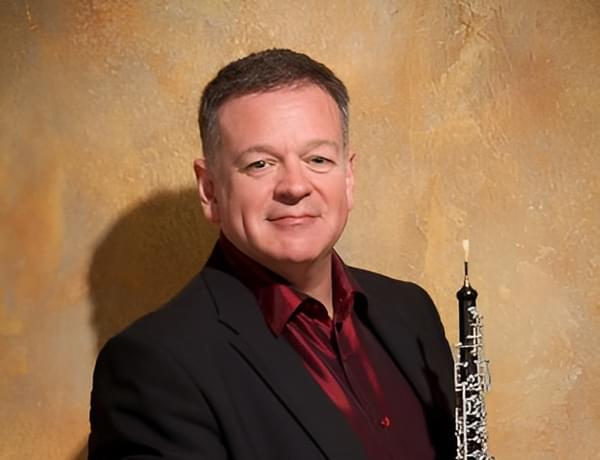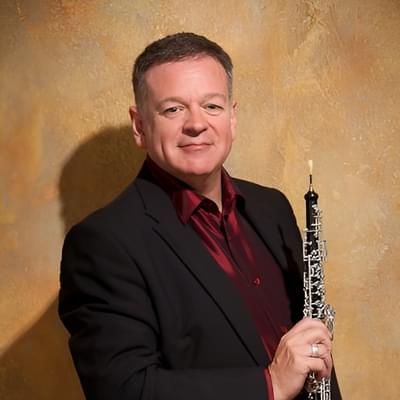CBSO Winds plays Mozart

Full programme
- Anna Clyne, Overflow (10mins)
- Mozart, Gran Partita for 13 Winds (43mins)
Performers

Nicholas Daniel
Play/Direct (Oboe)
Marie-Christine Zupancic
Section Leader Flute
Veronika Klirova
Principal Second Flute
Emmet Byrne
Principal Second Oboe
Oliver Janes
Section Leader Clarinet
Joanna Patton
Principal Second Clarinet
Anthony Pike
Bassett Horn
Steve Morris
Bassett Horn
Nikolaj Henriques
Section Leader Bassoon
Tony Liu
Principal Second Bassoon
Elspeth Dutch
Section Leader Horn
Neil Shewan
Horn
Julian Atkinson
Principal Double Bass
Introduction
I’ve regularly described playing Mozart’s Gran Partita as feeling like you are driving a huge juggernaut around a Formula 1 racing track at high speed.
It’s written for a huge ensemble; we play the most delicate yet rumbustious and atmospheric music that Mozart ever wrote. Performed without a conductor, it requires total trust between us all in rehearsals - particularly between the principal oboe, clarinet, basset horn and bassoon. Directing it is a delight, constantly learning new things and being given new insights into everyone’s experiences of the piece. My role involves balancing playing the divine oboe part to reveal the perfect overarching shape to the 7 movements.
Mozart clearly loved wind instruments: they are often like singers alongside the actual voices in his operas and are the actual singers in his instrumental music - even the flute that he is reputed to have disliked! I’m always profoundly grateful for Mozart's affection for us; it's true to say that he elevated winds to a far higher status than they had been enjoyed before. He was exposed to some of the truly great wind players of the time, including his friend, fellow Freemason and clarinet genius Anton Stadler, for whom he wrote the Clarinet Concerto. The piece was actually written for a crossbreed clarinet/basset horn in A - the key of A is important because of the three-part motto of the masonic lodge to which Mozart belonged: 'Liberty, Equality, Fraternity': A has 3 sharps in the key signature and the basset clarinet has three distinct registers. Equally, the Gran Partita has the number 3 deeply embedded in it in so many ways.
I was lucky enough to give the world premiere of Anna Clyne’s Overflow in Scotland during the pandemic. We worked on the piece online, with the composer in America. It’s scored for double wind quintet, an ensemble very few composers have written for. The piece has a beautifully poetic, watery inspiration combining influences from Emily Dickinson and Rumi with the central idea that the gentlest motion of a pearl on the ocean floor can have huge consequences on the sea’s surface - the marine version of the butterfly effect. I almost always wear pearls (I am doing so today) and I have just named my new British Blue Colourpoint kitten Miss Pearl.
I hope you enjoy this concert and its great showcase of wind instruments with the City of Birmingham Symphony Orchestra.
Nicholas Daniel
Play/Direct (Oboe)
Programme Notes
Anna Clyne was inspired by Emily Dickinson’s enigmatic poetry for Overflow in which the poet flirts with the mighty power of the sea. The wind ‘dectet’ portrays both the seabed, and the playful, sometimes sinister, creatures and forces within. Mozart’s Gran Partita is simply sublime – in the 1984 film Amadeus, Salieri is overcome with wonder on hearing it: “This was a music I'd never heard. Filled with such longing…”
Overflow
Anna Clyne (b.1980)
It’s tempting to assume that every work of art is in some way autobiographical, and Anna Clyne’s biography is certainly lively. Born in London, she studied music in Edinburgh, working (among other things) as a waiter, a cleaner and a florist before settling in the USA and building a reputation as one of the most original and communicative of living composers. She’s reported to have taught herself the Irish fiddle and the banjo during the Covid 19 lockdown. But Clyne herself tells of countless different ways in which she finds inspiration and channels creative energy. Her orchestral work Night Ferry (2012) used the life of Schubert as a starting point; Seamus Heaney also figured, and the music took shape through a series of abstract paintings (Clyne is also a visual artist).
In the case of Overflow (written in 2020 for the Scottish Chamber Orchestra), Clyne’s specific inspiration was literary. In her own words:
Overflow is a wind dectet inspired by Emily Dickinson’s poem By The Sea, in which we experience the ocean’s power over the poet’s imagination - both alluring, unsettling and dangerous. The line from which this piece takes its title “Would overflow with Pearl” reminded me of an image from Jelaluddin Rumi’s poem Where Everything is Music whereby the tiniest motion of a pearl on the ocean floor can cause great waves above. The opening sonority of Overflow also draws inspiration from Rumi’s words of a “slow and powerful root that we can’t see” with a low B-flat, the lowest pitch of the ensemble emerging from silence.
By The Sea
by Emily Dickinson
I started Early – Took my Dog –
And visited the Sea –
The Mermaids in the Basement
Came out to look at me –
And Frigates – in the Upper Floor
Extended Hempen Hands –
Presuming Me to be a Mouse –
Aground – opon the Sands –
But no Man moved Me – till the Tide
Went past my simple Shoe –
And past my Apron – and my Belt
And past my Boddice – too –
And made as He would eat me up –
As wholly as a Dew
Opon a Dandelion's Sleeve –
And then – I started – too –
And He – He followed – close behind –
I felt His Silver Heel
Opon my Ancle – Then My Shoes
Would overflow with Pearl –
Until We met the Solid Town –
No One He seemed to know –
And bowing – with a Mighty look –
At me – The Sea withdrew –
Wind Serenade in B flat, K.361/370a (“Gran Partita”)
Wolfgang Amadeus Mozart (1756-1791)
I. Largo – Molto allegro
II. Menuetto
III. Adagio
IV. Menuetto
V. Romanze
VI. Tema con variazioni
VII. Finale: Molto allegro
"It started simply enough: just a pulse in the lowest register – bassoons and basset horns – like a rusty squeezebox…And then suddenly high above it, sounded a single note on the oboe. It hung there unwavering, piercing me through, till breath could hold it no longer, and a clarinet withdrew it out of me and sweetened it into a phrase of such delight it had me trembling. The light flickered in the room. My eyes clouded…it seemed to me that I had heard a voice of God…" Peter Shaffer: Amadeus
The music that Salieri heard in that famous scene from Amadeus was the Adagio of Mozart’s Wind Serenade in B flat, K.361 / 370a – sometimes known by the name (mis-spelled, and scribbled on the score by an unknown hand) “Gran Partita”. But as every music-lover knows, you should never take anything in Amadeus as historical fact. We don’t know if the Gran Partita was ever performed at a mansion of the Viennese nobility; in fact, we don’t really know why it was composed or when (with one exception) it was performed at all. What we do know is that on 23rd March 1784, the following advert appeared in the Viennese newspaper Wienerblättchen:
"Herr Stadler, senior, in service with His Majesty the Emperor, will hold a musical concert for his benefit at the Imperial and Royal National Court Theatre, at which will be given…a great wind piece of a very special kind composed by Herr Mozart."
“Herr Stadler” was the clarinettist Anton Stadler (1753-1812), Mozart’s friend and (later) brother-Mason, for whom Mozart would write the Kegelstatt trio, Clarinet Quintet and Concerto, and to whom Wolfgang and his wife Constanze would give the nickname Ribisel (“redcurrant-face”). The concert, occurring in Lent – when the court orchestras and wind-bands (harmoniemusik) were temporarily dismissed – offered an opportunity for him to book an unusually large ensemble of the very best players. A memoir by the music writer Johann Schink, published the following year in Graz, seems to confirm that this was the first known performance
of at least part of the Serenade:
"I heard music for wind instruments today too, by Herr Mozart, in four movements – glorious and sublime! It consisted of thirteen instruments, viz. four corni, two oboi, two fagotti, two clarinetti, two basset-corni, a contre-violon, and at each instrument sat a master – oh what an effect it made, glorious and grand, excellent and sublime!"
But only four movements? And what about the evidence of the manuscript paper (which suggests that Mozart could have written the work as early as the summer of 1781). An anecdotal tradition (from Mozart's biographer Georg Nissen, possibly via Constanze herself) insists that this work was performed at Mozart’s wedding celebrations on 4th August 1782. The grand scale of the piece certainly suggests that it was created for a special occasion. Harmonie ensembles were, by this time, effectively standardised as sextets: two horns, two clarinets, two oboes. This was the size of the harmoniemusik at Emperor Joseph II’s court. If, as has sometimes been suggested, Mozart wrote his Serenade in a job application for a post in the Imperial household, he was unsuccessful. The court ensemble’s library would never contain even a single Mozart wind serenade.
So we’re left with the music – and what music! The full band plays four rich, solemn chords, and a solo clarinet - and then an oboe - begins to explore the huge musical space that Mozart has opened. It’s a powerful statement of intent, establishing a sense of scale in keeping with Mozart’s expanded ensemble. But this is a Serenade, after all, and after its comic-opera opening melody the way Mozart mixes and blends his instruments throughout his first movement is an entertainment in itself.
The stately first Menuetto is on an aristocratic scale, with two distinctive central Trio sections, one rich with clarinets, the second bright with oboes and horns. As for the Adagio, Shaffer still describes it best; the sense of the sublime here is so potent that around 1820 an unknown composer gave it words and re-arranged it as a sacred motet, Quis te comprehendat. The second Menuetto is on the same broad scale as the first, but it swings along like a country dance (or ländler), interrupted by a brusque, melancholy first Trio. (The second Trio has more of a lilt).
Few wind serenades of the 1780s extended beyond five movements, but Mozart adds a Romanze – a title he rarely used, possibly inspired by the tender, song-like quality of the melting opening melody, shared between clarinets and oboes. And then, to crown even this, comes a theme and six variations, seemingly borrowed from Mozart’s own C major Flute Quartet (1778) but here transformed into a marvellously inventive exploration of all the multicoloured possibilities of this extraordinary ensemble. The finale, when it comes, seems almost throwaway - a brisk, festive rondo designed to be heard a few streets distant. It’s a disarmingly cheerful finish to the greatest wind serenade of all time, “but after all…”, as Mozart once wrote, “it’s better to be short – and good”.
© Richard Bratby